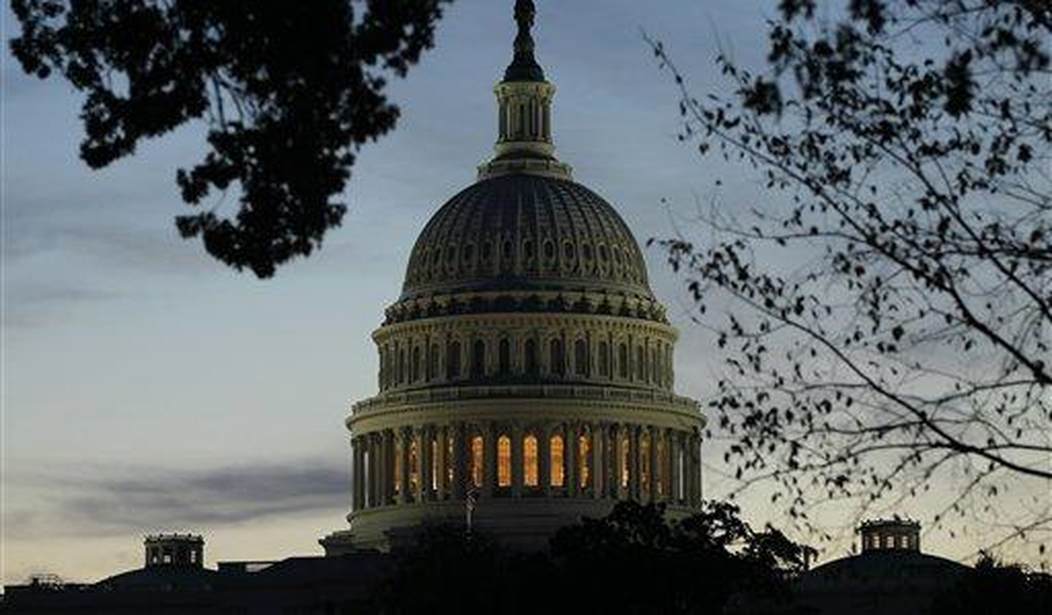What should we expect from tomorrow's midterm elections? Put succinctly, based solely on history, we should anticipate Republican gains. Barring a truly stunning reversal of fortunes, that outcome is already baked into the cake. The question is not if the GOP will have a better night than the ruling Democrats; the question is how big the wave will be. It could be an underwhelming ripple, especially if Democratic turnout is stronger than expected, Republican voters are complacent, and independents don't break against the party in power by decisive margins. It could also shape up into a sizable wave, in which Republicans gain solid control of the House, and narrowly win back the Senate. Or it could be one of the historic blowouts we will reference for years to come. How should we think about the likelihood of these various scenarios? Let's look at four factors:
First, race-by-race polling. Using this as our sole guide, we'd see a plausible chance for a somewhat decent night for Democrats. Republicans are polling just 'so-so' in a lot of the key races across the country, with Democrats still virtually tied (slightly ahead or behind) in a host of them. In wave years, late-deciders and independents tend to break in the same direction, triggering a domino effect against one party. If that happens, a lot of the not-horrible polling in these races could prove illusory, and the fact that many of these Democrats are stuck in the mid/mid-high 40's might be an ominous sign for them. But sometimes, trends are bucked. Actual Republican candidates in many of these races are trailing substantially behind the GOP generic ballot advantage in their states, and quite a few vulnerable Democrats are polling well ahead of President Biden's local approval rating. If they can defy political gravity like this, they can really limit the damage. For what it's worth, both left-leaning and right-leaning pollsters have recently said they believe the head-to-head polling may be underestimating GOP support. But sometimes polling errors cut the other direction.
Second, the broader national polling has been good, but not great, for the GOP. As of late Sunday, Republicans led on the 2022 generic ballot by 2.5 points, on average, per Real Clear Politics. It should be noted that any lead for Republicans on this metric is generally good news for the party. In 2020, Democrats had a lead of nearly seven points on this measure heading into election day. They won the House 'popular' vote by less than half of that margin, then Republicans gained double-digit seats. For the GOP to be ahead this time around is a positive sign for them, obviously -- but a lead in the low single digits isn't reflective of a massive wave like we saw in 2010, for instance. In short, the national polling currently points to a good-to-very-good night ahead for the opposition party, and provides more encouraging data than the more granular numbers in many of the closely-watched individual races.
Recommended
Third, there are the so-called 'fundamentals' of the cycle. I keep coming back to this point because it's extremely important. Let's say we had no access to any specific polling at all, but we knew the following: It's the first midterm election of a new presidency. The president's party controls all of Washington. The president is unpopular. Independents are very grumpy. Economic dissatisfaction is high (and I do mean high). And the out party leads handily on the top-tier issues identified by voters. Based on those facts alone, we would fairly confidently conclude that the out-of-power party would be heavily favored to win a substantial victory. That is true in a vacuum, and I suspect it will be true in practice, too. The fundamentals matter a lot, and virtually always do. For more on what a 'substantial victory' might look like, and how to look at the numbers as they come in, please go back and read this post from last week.
Finally, there are the professional prognostications and, perhaps more telling, the money. Professional prognosticators are the 'experts' who study this stuff for a living. They're sometimes wrong, as they were in 2016 (overall) and 2020 (they expected Democrats to expand their House majority, then Republicans held every seat they controlled, swept the toss-up races, and gained more than a dozen seats). But they try hard not to fail, because it's their business. It's embarrassing if they miss the mark, especially if they do so badly. Nearly all of the movement in the race ratings has been flowing toward the Republicans in recent weeks -- including some very blue seats getting a lot less solidly blue in the forecasts. The people weighing these ratings have access to public polling, like the rest of us, but also are privy to internal numbers and off-the-record conversations. This combination has led them to move the map decidedly rightward over the final stretch of the campaign. We've also seen dollars moving along similar patterns, with Democrats funneling money to protect safer seats, and Republicans looking to expand the map with aggressive moves into more Democratic territory. Those are signs of a confident opposition, and a ruling party engaged in triage.
If I had to choose, money and fundamentals speak louder than polls. The polls paint a 'middling wave' picture for Republicans. The other factors foretell a larger wave. Over the last six months, the question I've puzzled over is whether this year will end up looking more like 2018 in reverse (i.e. Republicans flipping the House with a pretty strong margin, but underperforming in the Senate), or 2014 (i.e. a late-breaking red wave that ended up being quite large after looking underwhelming for much of the cycle). Either scenario is still on the table, and maybe reality will split the difference, but if I had to shade one way or the other, I'd guess bigger than smaller. I'm not sure 2014 is the perfect analogy, but I'll note that the RCP generic ballot average was almost identical to this year's, with pundits asking all summer and fall why Republicans couldn't pull away in Senate races. That cycle's actual results beat the polling average by more than three percentage points nationally, the Senate races cascaded into the GOP column (they gained nine seats), and House Republicans boosted their already-sizable majority to a whopping 247 seats. I'm not necessarily predicting a rerun this week, but it's an interesting point of reference.
As for my projections, such things are always an educated shot in the dark. Last midterm cycle, my guesses ended up being spot on. Let's see how I do this year. My 'average' (and therefore best) guess is that Republicans end up with around 235 House seats, gain one net governorship, and ultimately control 51 Senate seats (one plausible scenario is winning NV and GA, but dropping PA). The pessimistic end of my spectrum would put Republicans at around 224 House seats and 50 Senate seats, technically stuck in the upper chamber minority. And my upside optimistic picks, which feel increasingly likely, would have the House GOP pushing 245 seats, and Mitch McConnell leading a 53-seat majority (R's hold all current seats, plus win NV/GA/AZ or NH) when all is said and done. I'll leave you with this, plus a good benchmark for how the evening might start to shape up:
This remains the key chart for how big GOP House gains will be: Biden vote share by the number of districts with that vote share. At R+3 or so nationally, the GOP starts to climb the levy that Democrats built with Biden +10 (or so) districts. 1/ pic.twitter.com/6EXtvDIHxC
— Sean T at RCP (@SeanTrende) November 6, 2022
Here's my rough thinking early on Election Night:
— Dave Wasserman (@Redistrict) November 4, 2022
- If #VA02 Luria (D) holds on, better night for Dems than expected
- If #IN01 Mrvan (D) or #VA07 Spanberger (D) lose, Rs likely winning 20+ seats
- If #NH02 Kuster (D) or #VA10 Wexton (D) lose, Rs likely winning 30+ seats https://t.co/XNIp07Sj0y

























Join the conversation as a VIP Member